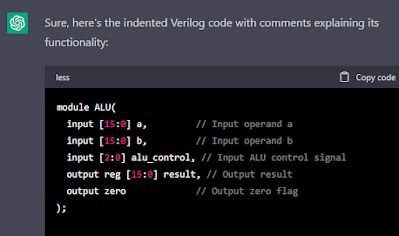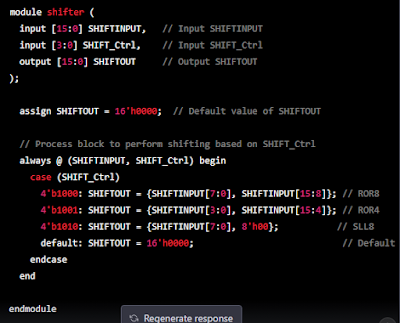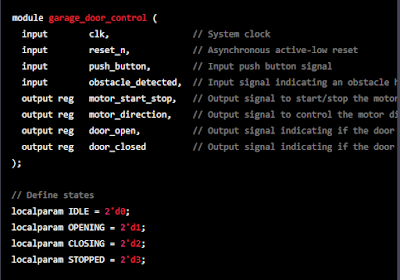A month ago, I heard about ChatGPT. I wanted to know how it will create Verilog RTL code. When I got to log in from their waitlist, I tried asking simple questions. I was impressed by the ability to spit out pretty clean and well-documented Verilog code. In this article, I'm documenting my brief experimentation with ChatGPT, results, and comments to provide a balanced picture.
Here is a shameless plug. All these questions discussed here are taken from my interview questions blog page. Check it out at rajesh52.blogspot.com . I have almost 47 questions listed about ASIC/FPGA's front-end design. All these questions require some thinking and awareness about ASIC design flow and physical implementation understanding.
I have conducted many interviews in the last 25 years of my career. I rarely find anybody giving a completely satisfactory answer to arbiter design questions. So I decided to pose that question first. I was surprised to get a solution that made sense on the surface. I did not check for the accuracy of the answer yet, but it made sense.
OK. Some progress, but it ignored my synchronizing prompt. I am quickly losing faith in the "I" part of AI.
This question is about synchronization, and later mentioning unrelated frequencies leads to the importance of Async FIFOs. ChatGPT behaved like a rookie Intern who is fast and confident but stupid. If the solution is available in the public domain, it can copy and present but lacks originality in problem-solving.
It discovered the functionality. The port list comments are better than the original.
Here are further comments
I am really impressed. This is a well-known function/component in open source. I agree. I set up my expectation lower. Maybe I secretly wanted ChatGPT to shine this time :)
I tried one more interesting task. Converting VHDL to Verilog.
I asked it to convert the Shifter VHDL code from this page.
https://www.fpga4student.com/2017/07/shifter-design-in-vhdl.html
I am really impressed. I won't trust it and will prefer to write a test bench to ensure the intention is correct, but the seemingly quality of the code is impressive.
Now I wanted to test its ability to generate test benches. First, I asked it to create a well-known Garage door opener design.
It spits out lengthy code.
Now I have warmed up to ChatGPT and almost started to believe it.
It provided a long nice looking test bench.
And then it did this.
Two initial statements running different tests and assigning values independently to the same variable. Nah, I lost confidence again. I can not trust ChatGPT to provide me trustworthy code. It acts like a very confident liar. You never know when you are getting duped.
I asked to rewrite the test bench in UVM. It gave a pretty elaborate test bench. I am not a UVM expert, so I won't comment on the correctness of testbench, but the sheer ability to spit out a test bench for a given module gives a jump start in writing a test bench from scratch.
I asked to provide an SDC file for previously generated clock_frequency_detector RTL. The result was simple but a good starting point if you need something to start.
ChatGPT is a worthy helper. It can speed up your productivity, it seems now.
As an RTL designer, I need some scripting help. I usually ask my colleagues with scripting experience or software folks. I decided to check out if ChatGPT can help me in that department.
Here is an example of a simple scripting task. I have a colossal netlist. I found a bug in a small unit that is instantiated many times. I fixed that small RTL block and wanted to run the same targeted test on the ECOed netlist. It is challenging to navigate a huge netlist to find out the exact location of that module in a hierarchical netlist. I want to break it up into smaller modules.
Once I hack the netlist module and establish equivalence, I can combine it to get the larger netlist.
I asked the following to ChatGPT.
Wonderful!
I asked it to run the script on the sample netlist I cludged together.
This is precisely what I wanted. I am impressed by the ability to write scripts.
Final thoughts: ChatGPT is relatively new, and a new subject of Prompt Engineering is still taking shape. Here is a summary of my observations.
- ChatGPT is a clever, confident liar regarding pure RTL design.
- It lacks physical and timing awareness of hardware when solving problems.
- It is good at finding and presenting well-known designs
- It is incredible in reverse engineering, rewriting code with indentation, and generating comments.
- It can help in jumpstarting synthesis and STA scripts.
- It was terrific in assisting the hardware engineer by writing helpful scripts.






































